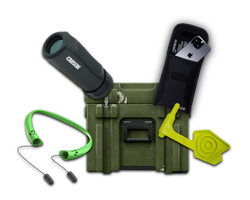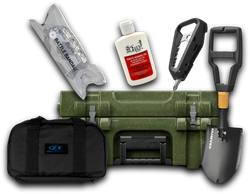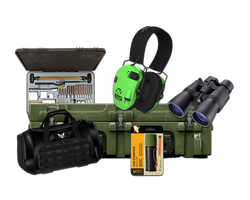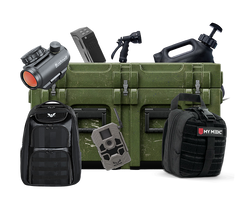How to Safely Shoot Steel Targets: A Comprehensive Guide
Table of Contents
- Introduction
- Understanding Steel Targets
- Recommended Distances for Shooting Steel Targets
- Factors Affecting Safety: Quality and Condition of Steel Targets
- General Safety Practices
- Conclusion
- FAQ Section
Introduction
For many gun enthusiasts, the thrill of hitting a steel target is unparalleled. The satisfying "ping" of a bullet striking steel offers immediate feedback that paper targets simply cannot match. However, the rising popularity of steel target shooting has also raised important questions about safety. Just how safe is it to shoot at steel targets, and what precautions should you take to minimize risks?
Understanding the nuances of shooting steel targets is crucial not only for ensuring your safety but also for preserving the integrity of your equipment. Steel targets are designed specifically for shooting, but they come with their own set of guidelines and considerations. Whether you're a seasoned marksman or a novice looking to practice, grasping the fundamentals of how to safely shoot steel targets will enhance your experience while keeping you out of harm's way.
In this blog post, we will delve into various aspects of shooting steel targets safely. You will learn about the recommended distances, types of ammunition, target material, and maintenance practices that are vital for safe shooting. By the end of this article, you will not only be informed but also empowered to make responsible choices when engaging with steel targets.
What You Will Learn
- The recommended distances for different firearms and ammunition types.
- The importance of target material and quality.
- Maintenance tips to ensure long-lasting and safe use of steel targets.
- General safety practices to follow while shooting at steel targets.
Why This Post Stands Out
Unlike many resources that merely scratch the surface of the topic, this comprehensive guide offers an in-depth look at each element of shooting steel targets safely. We combine expert insights with practical tips, making this a go-to resource for anyone interested in enhancing their shooting skills while prioritizing safety.
Understanding Steel Targets
What Are Steel Targets?
Steel targets are specifically designed for shooting practice. Unlike traditional paper or cardboard targets, steel targets are durable and can withstand repeated hits from various types of firearms. Made from high-quality steel, they are engineered to provide immediate auditory feedback—when struck, they emit a distinct sound that confirms a successful hit.
Types of Steel Used
The quality and type of steel used in targets are critical factors that affect their safety and longevity. The most commonly used steel grades for shooting targets are AR400, AR500, and AR550:
-
AR400 Steel: This is a medium-hardness steel that can withstand lower-caliber rounds. However, it can be damaged by higher-velocity impacts.
-
AR500 Steel: This is the most popular choice for steel targets due to its high hardness and resistance to wear. AR500 can handle most rifle calibers and is designed for repeated use.
-
AR550 Steel: A step up from AR500, this steel offers even greater durability and is ideal for high-velocity shooting.
Using inferior steel, such as mild steel, is highly discouraged as it can shatter upon impact, creating dangerous projectiles that can injure shooters.
Recommended Distances for Shooting Steel Targets
Handguns
When shooting steel targets with handguns, the recommended minimum distance is typically 10 to 15 yards. However, this can vary based on the caliber of the bullet and the type of steel used:
- 9mm: Minimum of 10 yards.
- .40 S&W: Minimum of 10 to 15 yards.
- .45 ACP: Minimum of 15 yards.
For high-velocity rounds or larger calibers, increasing the distance to 20 yards is advisable to minimize the risk of ricochet.
Rifles
Rifles are significantly more powerful than handguns, necessitating greater distances for safety:
- .223 Remington and 5.56 NATO: Minimum of 100 yards.
- .308 Winchester: Minimum of 100 yards.
- .30-06 Springfield: Minimum of 100 yards.
For any rifle caliber, it's prudent to maintain a distance of at least 100 yards unless you are using high-quality AR500 or AR550 steel targets designed for closer engagements.
Shotguns
The recommended distance for shotguns is generally around 25 yards. This distance helps ensure that the spread of the shot does not cause excessive splatter back towards the shooter.
General Guidelines
- Always refer to the manufacturer's specifications for minimum safe distances.
- The thicker the steel, the closer you can be to the target.
- Softer bullets (like lead) are safer to shoot from closer distances compared to jacketed or steel-core bullets.
- Always prioritize safety by maintaining a safe distance based on the caliber you're using.
Factors Affecting Safety: Quality and Condition of Steel Targets
Importance of Quality
Investing in high-quality steel targets is crucial for safety. As mentioned, AR500 and AR550 steels are engineered to withstand repeated impacts without compromising their structural integrity. Inferior materials can lead to dangerous ricochets and splatter.
Regular Maintenance
Maintaining your steel targets is essential to prevent accidents. Here are some practices to keep in mind:
-
Inspect Regularly: After each shooting session, inspect your steel targets for dents, scratches, and pitting. These imperfections can increase the likelihood of ricochets.
-
Replace Damaged Targets: If you notice significant damage to a target, replace it immediately. A compromised target is a safety hazard.
-
Clean the Targets: Periodic cleaning can help remove debris and lead buildup that can affect performance and safety.
Angling Your Targets
Angling your targets downwards is a proven method to minimize splatter. When bullets strike at an angle, they are more likely to deflect downwards rather than back toward the shooter. This is particularly vital when setting up free-hanging steel targets.
General Safety Practices
Personal Protective Equipment (PPE)
Always wear appropriate PPE when shooting steel targets:
-
Safety Glasses: Ensure they meet safety standards for shooting. Wraparound styles provide better protection against splatter.
-
Hearing Protection: The noise from gunfire and steel impacts can be loud, so ear protection is essential.
-
Long Pants and Closed-Toed Shoes: Protect your body from potential splatter.
Supervise Your Shooting Environment
Ensure that the shooting area is clear of obstructions and that no one is in the line of fire. Communicate clearly with your shooting partners about safety protocols.
Avoid Alcohol and Drugs
Never shoot while under the influence of alcohol or drugs. Impairment can lead to poor decision-making and increase the risk of accidents.
Follow Range Rules
Every shooting range has its own set of rules regarding shooting steel targets. Familiarize yourself with these rules and follow them closely.
Conclusion
Shooting steel targets can be an incredibly rewarding experience, providing instant feedback and an enjoyable challenge. However, it is imperative to approach this activity with a strong understanding of safety practices. By maintaining the proper distance, using high-quality steel, and adhering to safety guidelines, you can enjoy the thrill of shooting steel targets while minimizing risks.
As a member of the Crate Club community, you have access to a curated selection of high-quality tactical gear and survival tools that can enhance your shooting experience. Consider checking out the Crate Club subscription services for monthly deliveries of top-notch gear tailored to your needs.
For more gear options, visit the Crate Club Shop.
FAQ Section
1. What is the minimum safe distance for shooting steel targets?
The minimum safe distance varies by firearm type:
- Handguns: 10-15 yards
- Rifles: 100 yards
- Shotguns: 25 yards
Always refer to the manufacturer's guidelines for specific distances.
2. Can I shoot steel targets with any type of ammunition?
Not all ammunition is suitable for steel targets. Avoid using armor-piercing or high-velocity rounds on lower-grade steel. Stick to lead or softer bullets for closer distances and ensure the targets are rated for the ammunition you use.
3. How do I maintain my steel targets?
Inspect your targets regularly for damage, clean them to remove debris, and replace any that are severely dented or compromised.
4. Why should I angle my steel targets?
Angling your targets downward helps to deflect ricochets away from the shooter, reducing the risk of injury from flying fragments.
5. What PPE should I wear when shooting steel targets?
Always wear safety glasses, hearing protection, long pants, and closed-toed shoes to protect yourself from potential splatter.
Share this article



